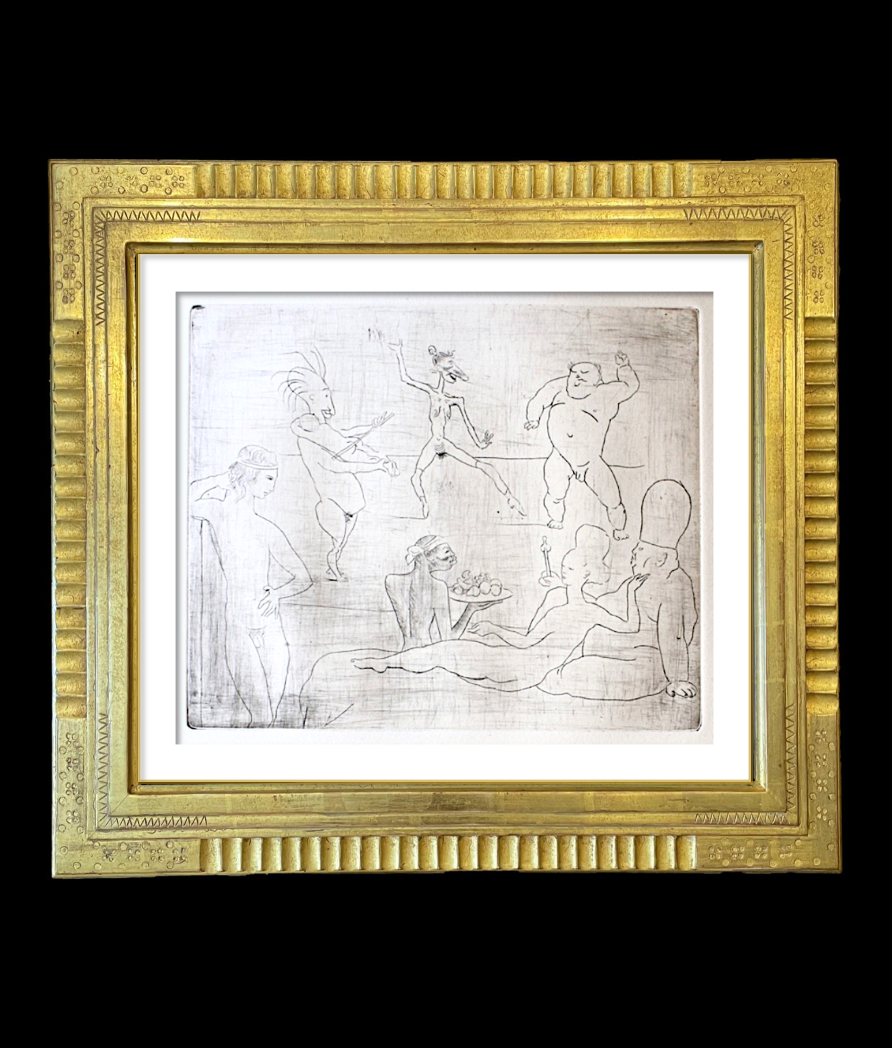

Title: Sex Orgy Party Barbarous Dance Drypoint Print By Picasso
Shipping: $29.00
Artist:
Period: N/A
History: Art
Origin: Southern Europe > Spain
Condition: N/A
Item Date: 1905
Item ID: 118
This is a very rare print, published in 1905 / The Barbarous Dance (in Front of Salomé and Hérod), from: Saltimbanques Suite | La Danse barbare [devant Salomé et Hérode]: La Suite des Saltimbanques PABLO PICASSO 1881-1973 Málaga 1881-1973 Mougins (Spanish) Title: The Barbarous Dance (in Front of Salomé and Hérod), from: Saltimbanques Suite | La Danse barbare [devant Salomé et Hérode]: La Suite des Saltimbanques, 1905 Technique: Original Drypoint on Van Gelder Zonen Wove Paper Paper size: 33 x 51 cm. / 26 x 20.1 in. Image size: 18.5 x 23.2 cm. / 7.3 x 9.1 in. Additional Information: This is an original drypoint by the artist Pablo Picasso. It was realised in 1905 in a limited edition of 250 unsigned and unnumbered impressions. A further 27 or 29 proofs were printed on Japan Ancien paper. This is the 15th plate in Picasso’s “La Suite des Saltimbanques”, Picasso’s first ever series of etchings. The suite was published in 1913 by Ambroise Vollard and printed by Louis Fort, Paris. The paper bears the Van Gelder Zonen watermark in the upper left margin. Exceptionally prolific throughout the course of his long life, Picasso achieved universal renown and immense fortune for his revolutionary artistic accomplishments, and became one of the best-known figures in 20th-century art. Picasso demonstrated extraordinary artistic talent in his early years, painting in a naturalistic manner through his childhood and adolescence. During the first decade of the 20th century, his style changed as he experimented with different theories, techniques, and ideas. After 1906, the Fauvist work of the slightly older artist Henri Matisse motivated Picasso to explore more radical styles, beginning a fruitful rivalry between the two artists, who subsequently were often paired by critics as the leaders of modern art.
Picasso's work is often categorized into periods. While the names of many of his later periods are debated, the most commonly accepted periods in his work are the Blue Period (1901–1904), the Rose Period (1904–1906), the African-influenced Period (1907–1909), Analytic Cubism (1909–1912), and Synthetic Cubism (1912–1919), also referred to as the Crystal period. Much of Picasso's work of the late 1910s and early 1920s is in a neoclassical style, and his work in the mid-1920s often has characteristics of Surrealism. His later work often combines elements of his earlier styles.
Pablo Picasso, 1905, Salomé (La danse barbare), pointe sèche sur cuivre / Pablo Ruiz Picasso[ Spanish: 25 October 1881 – 8 April 1973) was a Spanish painter, sculptor, printmaker, ceramicist, stage designer, poet and playwright who spent most of his adult life in France. Regarded as one of the most influential artists of the 20th century, he is known for co–founding the Cubist movement, the invention of constructed sculpture, the co–invention of collage, and for the wide variety of styles that he helped develop and explore. Among his most famous works are the proto–Cubist Les Demoiselles d'Avignon (1907), and Guernica (1937), a dramatic portrayal of the bombing of Guernica by the German and Italian airforces during the Spanish Civil War.